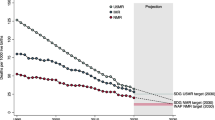“………. South Sudan will rank near the bottom of all recognized human development indices. The statistics are truly humbling. It has the world’s highest maternal mortality rate. Estimates of illiteracy among the female population exceed 80 percent. More than half of its people must feed, clothe and shelter themselves on less than a dollar a day”.
Ban Ki-moon, Secretary General, The United Nations.
(‘Standing by South Sudan’; New York Times; 7th July 2011).
Abstract
With its independence secured on 9th July 2011, the Republic of South Sudan faces a daunting task to improve public health and primary care in one of the poorest countries in the world. Very high maternal and child mortality rates must be a major concern for the new national government and for the many international agencies working in the country. Poor maternal health outcomes are primarily due to poor prenatal, delivery and post natal care services in health facilities, coupled with low literacy, widespread poverty, and poor nutrition among the general population. Child mortality is the result of widespread malnutrition, pneumonia, malaria, vaccine preventable diseases and diarrheal diseases. National responses to HIV and AIDS with international assistance have been encouraging with relatively low rates of infection. This paper explores barriers and identifies opportunities available to work toward achieving the targets for Millennium Development Goals (MDGs) 5 and 4 to reduce maternal mortality from its current rate of 2,054 deaths per 100,000 live births, and child mortality (currently 135 deaths per 1,000 live births) respectively in the new nation. National and international organizations have a social responsibility to mobilize efforts to focus on maternal, child health and nutrition issues targeting the worst affected regions for improving access to primary care and obstetrical services. Initiatives are needed to build up community access to primary care with a well supervised community health workers program, as well as training mid level management capacity with higher levels of funding from national and international sources to promote public health than current in the new republic.
Similar content being viewed by others
References
Moszynski, P. (2011). South Sudan: A nation born in crisis. BMJ, 342, d3726.
Burki, T. (2011). Infectious diseases burden in South Sudan. Lancet Infectious Diseases, 11, 266–267.
WHO, UNICEF, UNFPA, & World Bank. (2010). Trends in maternal mortality: 1990 to 2008. Geneva: World Health Organization. http://whqlibdoc.who.int/publications/2010/9789241500265_eng.pdf. Accessed 2011.
Ministry of Health, Government of Southern Sudan, a Southern Sudan Commission for Census, Statistics and Evaluation. (2006). Southern Sudan household health survey. South Sudan. http://www.bsf-south-sudan.org/sites/default/files/SHHS.pdf. Accessed 2011.
The Republic of Sudan Ministry of Welfare and Social Security, National Population Council General Secretariat. (2010). Sudan millennium development goal report 2010. http://www.sd.undp.org/doc/Sudan%20MDGs%20Report%202010.pdf. Accessed 2011.
UNICEF, WHO, World Bank, United Nations DESA/Population Division. (2010). Levels and trends in child mortality, report 2010. http://www.childmortality.org/stock/documents/Child_Mortality_Report_2010.pdf. Accessed 2011.
Wakabi, W. (2011). Lul Riek: Helping to improve public health in South Sudan. Lancet, 377, 2171.
Wakabi, W. (2011). South Sudan faces grim health and humanitarian situation. Lancet, 377, 2167–2168.
Tulchinsky, T. H., & Varavikova, E. A. (2009). The new public health (2nd ed.). USA: Elsevier.
Author information
Authors and Affiliations
Corresponding author
Rights and permissions
About this article
Cite this article
Rai, R.K., Ramadhan, A.A. & Tulchinsky, T.H. Prioritizing Maternal and Child Health in Independent South Sudan. Matern Child Health J 16, 1139–1142 (2012). https://doi.org/10.1007/s10995-011-0886-6
Published:
Issue Date:
DOI: https://doi.org/10.1007/s10995-011-0886-6




